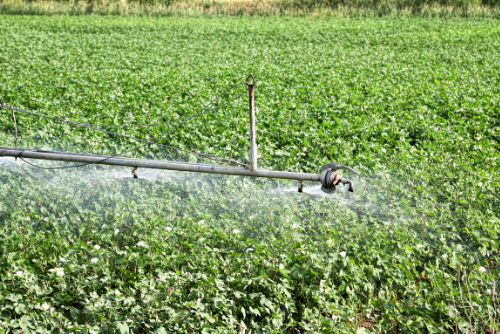Despite being a highly sustainable crop, cotton is often misunderstood. Some claim that growing cotton uses too much water, pesticides, and energy, while taking land away from food crops and reducing air quality. The truth is, none of these things are true anymore thanks to the advent of modern farming techniques and practices—but the cotton industry is still working to bust these outdated myths. In this article, we’ll look at each of them, one by one.
Myth #1: Cotton Reduces Air Quality
The cotton crop actually has a small greenhouse gas footprint. In fact, when the carbon stored in the fiber is taken into account, all carbon emissions during production are cancelled out by what was already present.
Additionally, the U.S. cotton industry is working with diligence to improve air quality. Since 1980, greenhouse gas emissions from cotton production have decreased by more than 40 percent.
Myth #2: Cotton Uses Too Much Energy
There was once a time when cotton required a lot of energy to produce, but thankfully, those days are long gone. Reduced tillage techniques have greatly reduced the amount of fuel required to use on the farm. Meanwhile, fewer pesticide applications mean fewer trips for the tractors, which leads to more energy savings.
Cotton also produces seed—close to 700 pounds of it for every 480-pound bale of fiber. Each acre of cotton grown yields enough seed to produce over 20 gallons of biodiesel. In total, the cotton industry has reduced energy use by more than 50 percent over the last four decades.
Myth #3: Cotton Uses Too Much Water
Did you know that agriculture accounts for 70 percent of water use worldwide, but growing cotton (globally) accounts for just 3 percent of all agricultural water used? Not only is cotton highly drought resistant, but also, cotton growers have taken many measures to improve water efficiency in recent decades. Most U.S. cotton, and half of cotton worldwide, now survives on rainfall only. Since 1980, irrigation water use has decreased almost by 80 percent on a unit of production per acre basis. It has also decreased on an absolute basis by over 50 percent.
Myth #4: Cotton Uses Too Many Pesticides
Experts estimate that between 20 and 40 percent of global crop production is lost to pests each year. That makes it even more remarkable that the global cotton industry accounts for only 6.4 percent of pesticide sales. Thanks in large part to the introduction of new seed varieties and the hugely successful Boll Weevil Eradication Program, today’s U.S. cotton growers do half as many pesticide applications as the previous generation of growers. Just 5 grams of pesticides are used per kilogram of cotton nowadays, with many of them targeting specific species. This allows beneficial organisms to survive unharmed and continue to fill their natural roles in the ecosystem.
Myth #5: Cotton Takes Up Too Much Land and Soil
Cotton crops occupy just 3 percent of the world’s agricultural land. Moreover, U.S. cotton producers have cut land use nearly in half over the last 40 years.
Thanks to modern farming technology, huge improvements in production efficiency have allowed U.S. cotton growers to produce almost twice as much cotton per acre now than they did in 1960. This means the amount of land used for cotton farming in the U.S. has decreased while cotton yields have increased. U.S. cotton farmers employ conservation tillage, which is the practice of leaving last year’s crop residue in the field before and after planting the next crop. This helps reduce soil loss, increase water holding capacity, and minimize runoff. Since 1980, soil erosion has decreased by 35 percent.
We hope these explanations have helped to dispel outdated misconceptions of the cotton crop, creating a better understanding of cotton’s sustainable nature. From farmers to scientists to experts, the cotton industry has made enormous strides in sustainability and efficiency over the last several decades, and we’re proud to spread the word about these advancements.
To learn more about this topic, please visit our Cotton Sustainability page.
